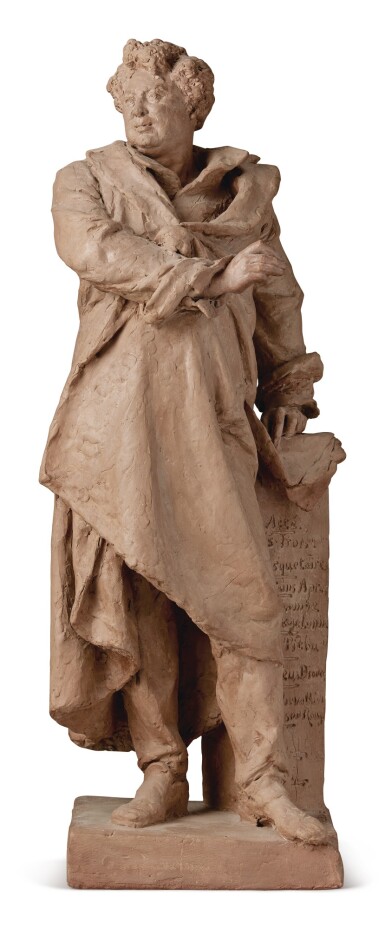Master Sculpture and Works of Art Part II
Master Sculpture and Works of Art Part II

Property from a Distinguished Private Collection, Washington, D.C.
Albert-Ernest Carrier-Belleuse
model for a monument to Alexandre Dumas, père (1802-1870)
Lot Closed
January 30, 09:00 PM GMT
Estimate
15,000 - 25,000 USD
Lot Details
Description
Albert-Ernest Carrie-Belleuse (Anizy-le-Château 1824 - 1887 Paris)
French, circa 1884
model for a monument to Alexandre Dumas, père (1802-1870)
signed A. Carrier-Belleuse on base and on the square pillar: TROiS MOUSQUETAiRES./ VINGT Ans APRÈS,/ LES QUARANtE CinQ./ LA ComtESSE de CHARNY./ AngE PiTOU/ LA REiNE MARGOT./ Comte de MontE CRisto./ AcTÉ./ Etc. Etc. Etc.
terracotta
height 30 1/4 in.; 77cm.
Carrier-Belleuse and Alexandre Dumas were good friends and this intimacy and understanding inspired the informal, yet lively depiction of the famous French author of The Three Musketeers and The Count of Monte Cristo. The monument was erected at Villers-Cotterêts, Dumas hometown, in 1885; later destroyed in 1942 and recast by the Courbertin foundry in 2005. The present terracotta is one of only a handful of reduced versions of the statue, each with variations, exemplifying Carrier-Belleuse’s immaculate technique in making casts with the freshness of individually modeled terracottas.
Dumas is shown in a dynamic pose, standing and turning to his right as if answering to a call. He holds a writing quill in one hand and rests the other on a bundle of papers. Dumas wears a large robe de chambre, pulled up by his right arm, creating deep diagonal folds as he steps forward with his left leg. Dumas’s characteristic frizzy hair and individual features identify his well-known mixed parentage. As Hargrove has noted: ‘Carrier-Belleuse has conveyed his friend’s witt and charm for us as faithfully as he captured the external peculiarities. The jovial Dumas pauses, momentarily distracted from his work. His eyes beam out in anticipation from his fleshy face; the extravagant bush of hair makes a fitting cap for his fertile brain. The open shirt reveals his bull neck.’
Carrier-Belleuse made his monument to Dumas towards the end of his career at a time when he was both successful and famous. His design looks back for inspiration to a model he designed of John Milton for the Derby porcelain factory during his English sojourn in the 1850s. It also presages the notorious monument to Honore Balzac by Rodin, Carrier-Belleuse’s pupil.
Other versions of this rare terracotta of Dumas are in the Musée Alexandre Dumas, Villers-Cotterêts; Musée Carnavalet, Paris; J. Paul Getty Museum, Malibu; one formerly in the Mme. Alexandre Popoff collection; and one sold at auction at Lisbon, Portugal in 2019.
RELATED LITERATURE
J. Hargrove, The Life and Work of Albert Carrier-Belleuse, New York, 1977, p. 95;
J. Hargrove and G. Grandjean, Carrier-Belleuse. Le Maître de Rodin, exh. cat. Palais de Compiègne, 2014, pp. 168-9, cat. 125
